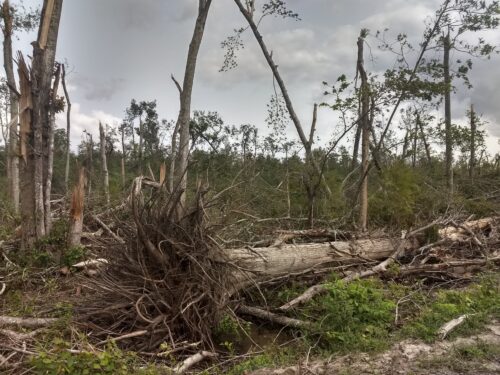Field Notes: Disturbance Ecology in the Swamp
December 22, 2020 12:09 pm

By Scott Bachman, Senior Area Forester, and Meghan Mulroy-Goldman, Community Forester – Blackwater Work Area
Earlier this year, Meghan Mulroy-Goldman and I took the opportunity to travel to the Great Dismal Swamp National Wildlife Refuge. This swamp once covered more than one million acres in southeastern Virginia and northeastern North Carolina and was dominated by tree species like bald cypress, black tupelo, and Atlantic white-cedar. Many species of wildlife roamed the area — even panthers! The swamp has both enchanted and vexed Europeans who have tried to exploit it. George Washington even attempted — and failed— to drain the swamp for conversion to agriculture. Runaway slaves found refuge in the deep interior of the swamp, giving rise to a rather large and thriving community.
Today, the wildlife refuge protects more than 112,000 acres, home to species like bear, deer, snakes, amphibians, and lots of mosquitos! We visited with Jen Wright, a biologist at the refuge, to talk about the Atlantic white-cedar being grown at DOF’s Garland Gray Forestry Center for restoration work at the swamp. On our way out the door, she asked if we had seen the path of the early August tornado through the swamp. On August 4, a tornado tore through the town of Courtland in Southampton County, but I had not heard of a tornado on that day in Suffolk. Jen showed us some remote sensing images and told us to take a ride to Lake Drummond and see for ourselves.
Before working for the Department of Forestry, Meghan studied disturbance ecology at Purdue, so she was eager to take a look at the site. Here, she explains a little of what she studied:
There is an old saying, “If a tree falls in the forest and no one is around to hear it, does it make a sound?” While this phrase is often said in jest, it brings to light an important truth about forests — trees do fall from time to time. They may die from any number of diseases or insect pests, or they may be knocked over by heavy winds. Each time this happens, it creates what forest ecologists call a disturbance. There are fancy science definitions of this term, but disturbances are, in the most basic sense, events that change ecosystems. They come in all shapes and sizes, from a single tree falling and small blow-down events caused by wind storms, to tornados, hurricanes, and crown fires.
The word disturbance, and some of the events that are considered disturbances, might make you think they are a bad thing. In reality, however, they are an important force in forming natural communities across the globe. These include the longleaf pine savannas in the southeastern states, oak-hickory forests of the eastern U.S., and even the redwood forests of California. Every ecosystem has its own disturbance regime, or historical pattern of disturbances. These patterns influence the plant species that are present in an area. To understand why, we have to talk about another important ecology concept: succession.
Succession is the continual changing of species that make up a community over time. Some species, called early-successional species, come in soon after a disturbance. They like a lot of sunlight and can often deal with some pretty tough ecological conditions. As time passes, the early-successional species pave the way for species that may tolerate a bit more shade. We call these mid-successional species. Finally, some species that don’t require much sunlight at all — the late-successional species — start to grow under the shade of those mid-successional species that are still alive. This process occurs every time there is a disturbance — from large disturbances like fires, to small disturbances like a single tree falling. You can see a quick overview of succession here. (The secondary succession portion of the video applies to the situation we observed after the tornado.)
What’s more, this process also helps to increase diversity. As conditions change over time, the different successional species overlap, increasing the overall number of species in an area. Disturbances also create diversity by creating patches that are in different stages of succession. This is what happens if a single tree falls. The gap it creates might not be too big, but that gap allows for more sunlight to reach the forest floor, and for different species to grow in its place.
This is a perfect description of what Meghan and I saw on that afternoon in the Dismal Swamp. The species that had made up much of the overstory — red maple, tupelo gum, green ash and a few baldcypress — had been toppled, even twisted. The site looked utterly devastated. But when we looked a little closer, we could see that under the tattered boles of mature trees were green shoots. Many of these were baldcypress saplings, less than three feet tall for the most part. Baldcypress is a relatively shade-tolerant tree when young and can persist in the understory for many years until there is a disturbance. Now was their chance! The heavy shade from the overstory was gone, and sunlight was there to be had for the quickest to reach for the sky.

It will be interesting to see what this disturbed forest looks like 5, 10, or even 30 years from now. I am sure it will be easy to pick out the path of this tornado for a long while in the future by the change in the vegetation.
Incidentally, swamp forests like the one we visited in the Great Dismal Swamp are globally rare. For more information about this forest type, check out this information from the Department of Conservation and Recreation’s Natural Heritage Division.
Tags: Ecology
Category: Forest Management
